When I first stumbled upon this recipe while doom-scrolling through food blogs at midnight, I had no idea this humble Spanish-Filipino stew would become my go-to dish for family gatherings. Like many Filipino dishes, cocido (also called pochero, depending on which island you're from) tells the story of our Spanish colonial past, but with a delicious twist that's uniquely ours.
What really hooked me was discovering how my Sunday leftovers - that ham from breakfast, the rotisserie chicken from Saturday, even those saba bananas getting too ripe on my counter - could transform into this luxurious three-course meal.
Jump to:
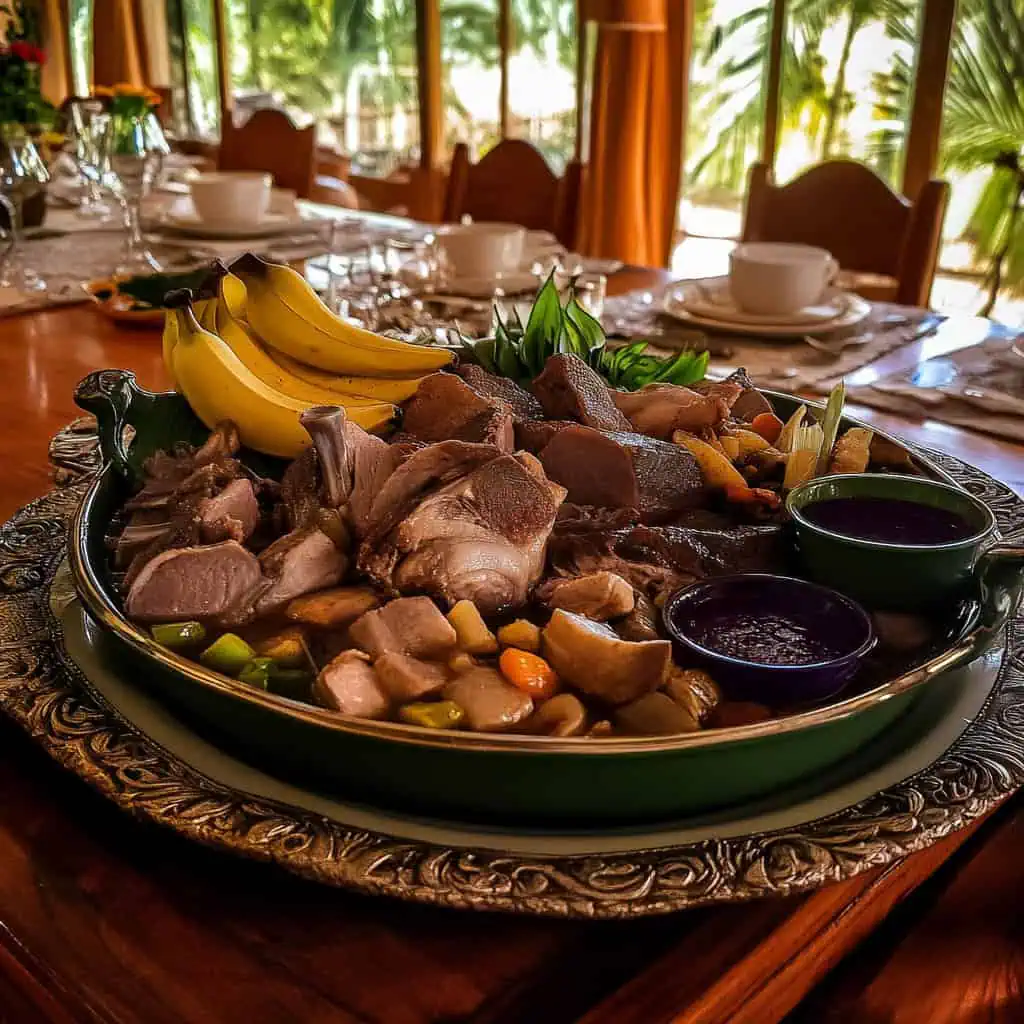
Why You'll Love This Recipe
- Perfect for transforming leftover holiday meats into a new, exciting dish
- Impressive three-course presentation that's perfect for special occasions
- Rich, flavorful broth that develops deep flavors during slow cooking
- Versatile recipe that can be adapted based on available ingredients
- Complete meal with proteins, vegetables, and legumes in one dish
- Great for batch cooking and meal prep
Ingredients
This Filipino-Spanish Cocido combines ingredients that tell a story of cultural fusion. The beef shanks and bone-in chicken create a rich, collagen-filled broth that forms the foundation of this celebratory dish. Chorizo de bilbao and ham add depth and smokiness, reflecting Spanish colonial influence.
The saba bananas—uniquely Filipino—bring subtle sweetness that balances the savory elements, while garbanzo beans provide heartiness and texture. Fresh vegetables like cabbage, green beans, and pechay add color, nutrients, and contrasting textures.
This thoughtful combination creates a complete meal where each ingredient serves a purpose: the meats for protein and flavor, vegetables for freshness, and the berenjana sauce for a smoky contrast that ties everything together.
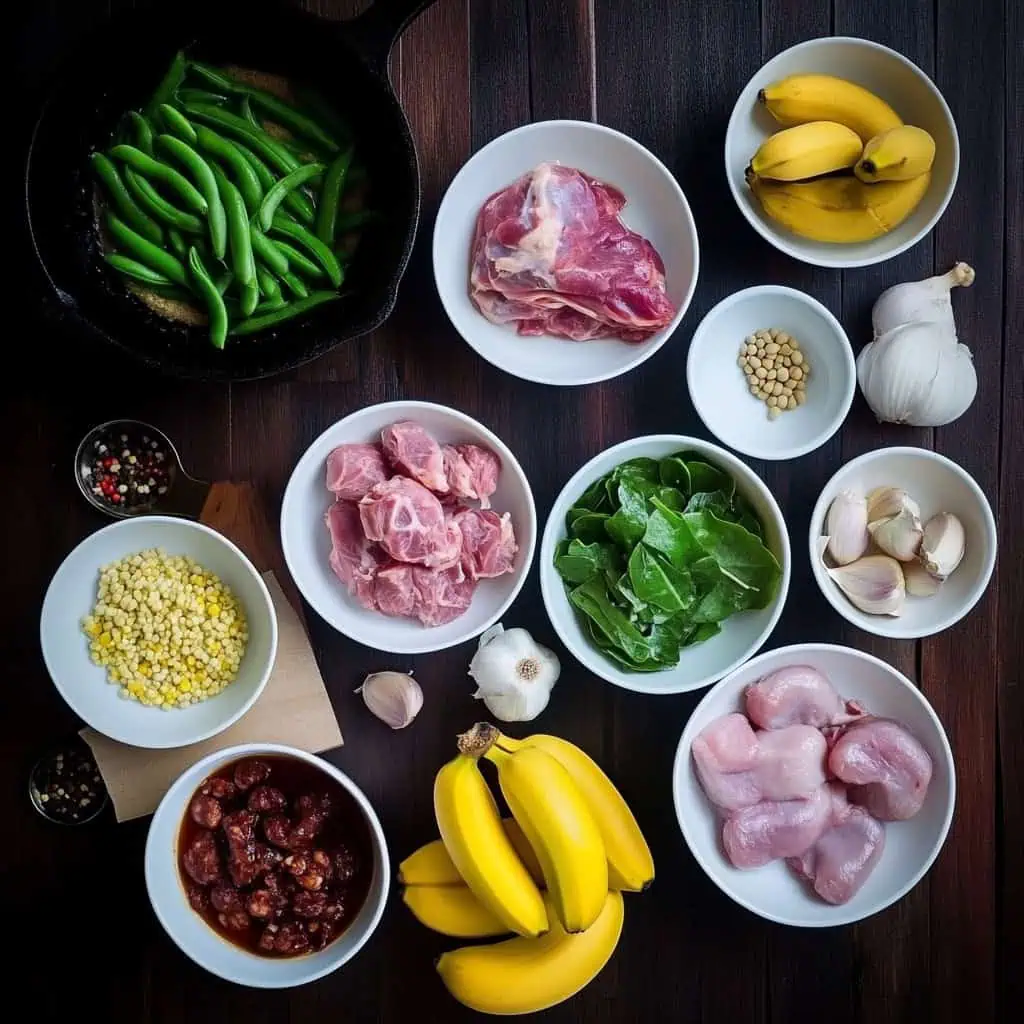
- 1 pound bone-in beef shank
- ½ whole chicken, cut into serving parts
- 5 ounces chorizo de bilbao
- 4 ounces ham slices
- 3 saba bananas, peeled and halved
- 15 ounces garbanzo beans, drained
- 1 head cabbage, quartered
- 8 pieces green beans, stemmed
- 1 bunch pechay, ends trimmed and leaves separated
- 1 large onion, peeled and quartered
- 3 cloves garlic, peeled
- 1 teaspoon peppercorns
- 8 cups water
- 2 teaspoons salt
- 3 tablespoons canola oil
For the Berenjana Sauce (Eggplant Relish):
- 3 eggplants
- 3 cloves garlic, peeled and minced
- 2 tablespoons vinegar
- 1 tablespoon oil
- Salt to taste
Equipment
- Large stock pot (kaldero) - For slow-cooking the meat and developing the rich, flavorful broth
- Wide pan (kawali) - For browning meats and sautéing ingredients to enhance flavor
- Slotted spoon (sandok) - For removing scum from the broth to keep it clear and clean
- Sharp knife (kutsilyo) - For cutting meats and vegetables with precision
- Cutting board (sangkalan) - For safe and hygienic food preparation
- Serving platter (bandehado) - For the traditional elegant presentation of meats and vegetables
- Soup tureen - For serving the clear, aromatic broth as the first course
- Tongs - For easily handling and turning meats while browning
- Fine-mesh strainer - For straining the broth if desired for a more refined presentation
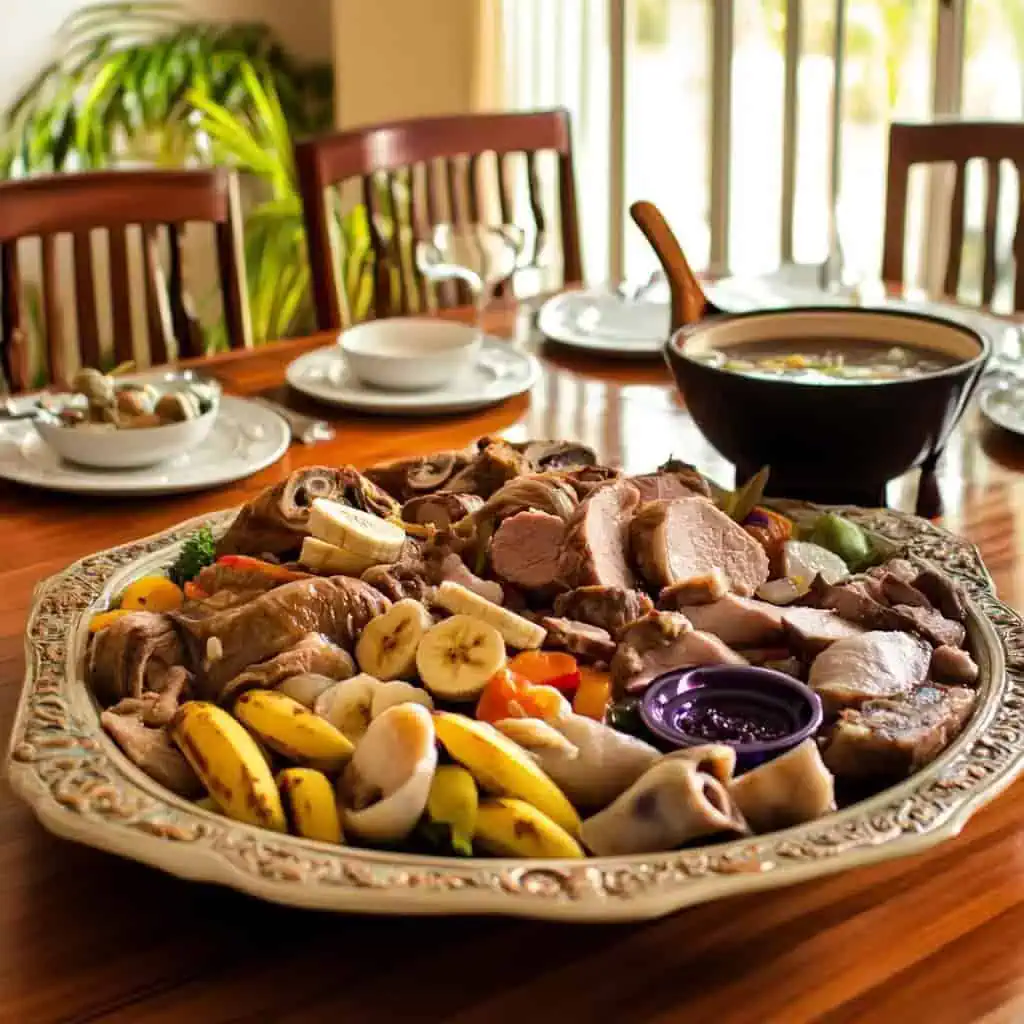
How To Make
- Heat one tablespoon of oil in a large pot over medium heat. Sear the beef shanks on both sides until they develop a nice brown color, about 3-4 minutes per side. Remove the beef and set aside.
- Pour the water into the same pot and bring it to a boil. Return the beef shanks to the pot and skim off any gray foam that rises to the surface. Once the broth looks clear, add the quartered onions, whole garlic cloves, peppercorns, and salt. Lower the heat to a gentle simmer, cover the pot, and let it cook for about 1½ to 2 hours, or until the beef is fork-tender.
- While the beef is cooking, prepare your berenjana sauce. Place the whole eggplants directly over an open flame on your stove, turning occasionally until the skin is completely charred. Run them under cold water and peel off the blackened skin. Mash the soft eggplant flesh in a bowl, then mix in the minced garlic, vinegar, oil, and salt to taste. Set this sauce aside.
- In a separate wide pan, heat another tablespoon of oil. Add the saba bananas and cook until they're lightly golden brown on all sides. Remove them and set aside. In the same pan, cook the chorizo de bilbao for 1-2 minutes until it releases its red oil. Remove and set aside. Add the chicken pieces to the pan and cook until they're lightly browned on all sides.
- Once the beef is tender, add the browned chicken, ham slices, and chorizo to the pot. Cook for about 15-20 minutes until the chicken is fully cooked through. Add the garbanzo beans and browned saba bananas, letting them cook for 3-5 minutes to heat through.
- Next, add the green beans and cabbage quarters to the pot. Cook until they're tender but still have a slight crunch. Finally, add the pechay leaves and cook for just one more minute. Taste the broth and add more salt if needed.
- To serve your cocido the traditional way, first ladle the hot, clear broth into bowls as your first course. Then arrange all the vegetables and garbanzo beans on a large platter for your second course. Finally, present all the meats on another platter for the third course. Serve everything with steaming white rice and the berenjena sauce on the side.

Tips from Lola's Kitchen
- Choose the right beef: Select beef shanks with plenty of connective tissue and marbling for a richer, more gelatinous broth.
- Patience pays off: Don't rush the simmering process—low and slow cooking develops complex flavors.
- Skim diligently: For a crystal-clear broth, skim regularly during the first 30 minutes of cooking.
- Layer your seasonings: Add salt gradually throughout the cooking process rather than all at once.
- Banana selection matters: Choose firm, yellow-green saba bananas that will hold their shape during cooking.
- Rest your meat: Allow meats to rest for 5-10 minutes before serving for juicier results.
- Serve right away: This dish is at its best when served fresh and hot.
- Don't overcrowd: Brown meat in batches to ensure proper caramelization.
Substitutions
- Beef Shank: Substitute with beef brisket, oxtail, or beef short ribs for equally flavorful results.
- Chorizo de Bilbao: Spanish chorizo or Filipino longganisa can be used as alternatives.
- Saba Bananas: Plantains work well, though they're less sweet. In a pinch, firm regular bananas can be used.
- Pechay: Bok choy or spinach make excellent substitutes with similar cooking times.
- Garbanzo Beans: White beans or kidney beans can replace garbanzos if needed.
- Ham: Bacon (thick-cut) or pancetta can provide a similar savory element.
- Canola Oil: Any neutral cooking oil like vegetable or sunflower oil works fine.
Troubleshooting
- Tough Meat: If meat isn't tender after the recommended cooking time, continue simmering in 30-minute increments until fork-tender.
- Cloudy Broth: For a clearer broth, make sure to skim more frequently during the first 30 minutes of cooking and maintain a gentle simmer rather than a rolling boil.
- Too Salty: Add a peeled, quartered potato to the broth to absorb excess salt, then remove before serving.
- Too Bland: Enhance flavor by adding fish sauce (patis) gradually to taste, or concentrate the broth by simmering uncovered for 10-15 minutes.
- Vegetables Too Soft: Add firmer vegetables like cabbage and green beans later in the cooking process to maintain their texture.
- Berenjana Too Bitter: Add a pinch of sugar and more vinegar to balance the flavor of the eggplant relish.
Storage & Reheating
- Refrigerator: Store components separately if possible—broth, meats, and vegetables—for up to 3 days in airtight containers.
- Freezer: The broth and meats can be frozen for up to 3 months, but vegetables are best prepared fresh when reheating.
- Reheating on Stovetop: Place broth in a pot and bring to a gentle simmer. Add meats first until heated through, then add vegetables just long enough to warm them without overcooking.
- Microwave Reheating: Heat portions for 2-3 minutes on high, stirring halfway through. Add fresh herbs or a squeeze of citrus after reheating to brighten flavors.
- Reviving Flavors: When reheating, add a splash of chicken stock or water if the broth has reduced too much.
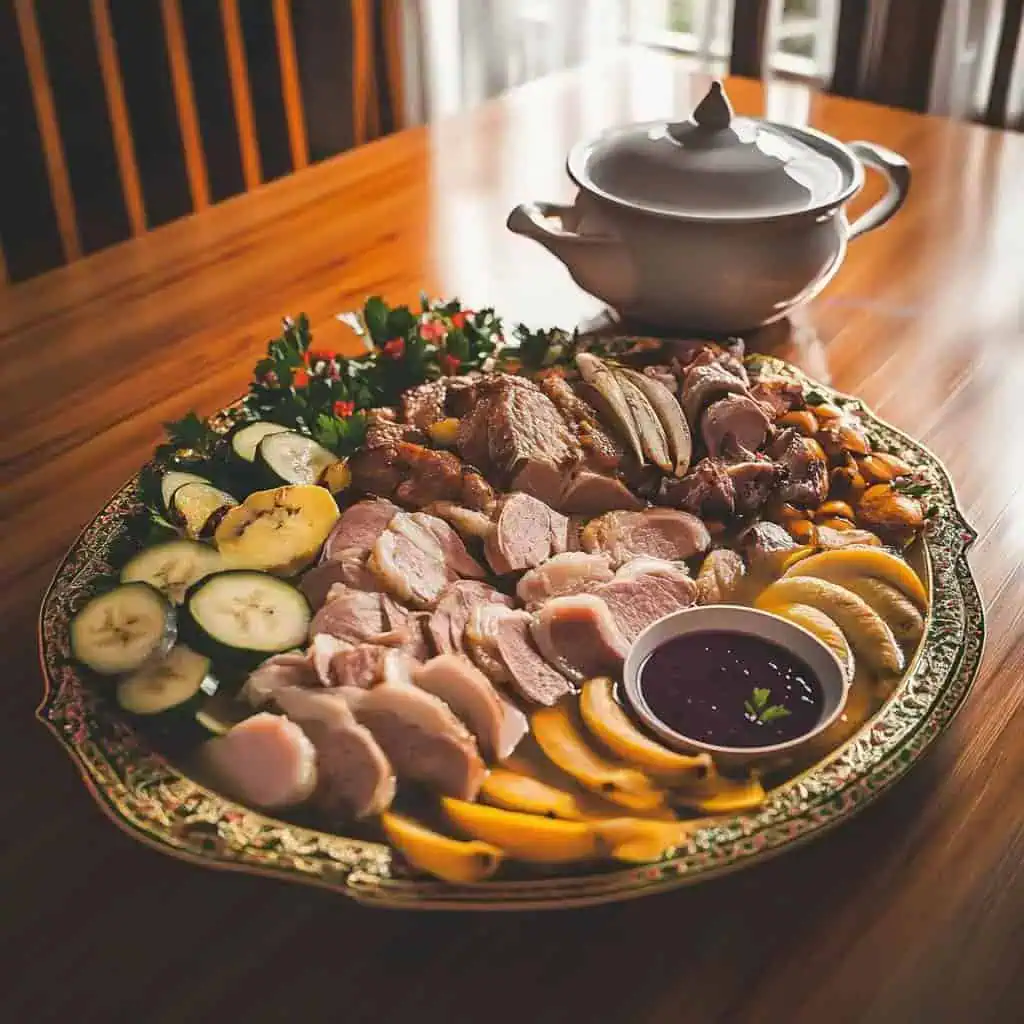
FAQ
Can I make this in a slow cooker?
Yes, cocido adapts beautifully to slow cooking. Brown the meats first, then combine all ingredients except the vegetables in a slow cooker. Cook on low for 8-10 hours or high for 4-6 hours. Add vegetables during the last 30-60 minutes of cooking.
Can I prepare components ahead of time?
Absolutely! The broth and meats can be prepared a day in advance, which actually improves flavor. Store them together in the refrigerator and skim off any solidified fat before reheating. Add fresh vegetables when ready to serve.
How do I know when the beef is tender enough?
The beef should easily pull apart with a fork with minimal resistance. If you're using beef shanks, the meat should be starting to separate from the bone.
Can I use canned garbanzo beans?
Yes, drained and rinsed canned garbanzo beans work perfectly in this recipe and save considerable time.
What's the best way to serve cocido for a dinner party?
For an impressive presentation, set up three serving stations: elegant bowls for the broth with fresh herbs floating on top, a platter of colorful vegetables artfully arranged, and a board of sliced meats. This showcases the traditional three-course serving style.
Is cocido gluten-free?
The basic recipe is naturally gluten-free, but always check your chorizo and ham as some varieties may contain gluten-based fillers or seasonings.
What makes Filipino cocido different from Spanish cocido?
The Filipino version incorporates unique local ingredients like saba bananas and pechay, and typically includes a greater variety of meats. The berenjana sauce is also a distinctive Filipino adaptation.
Can I make a vegetarian version?
Yes, substitute the meats with hearty mushrooms like portobello and king oyster mushrooms, double the garbanzo beans, and use vegetable broth. Add extra vegetables like carrots, potatoes, and corn for a satisfying vegetarian cocido.
Related
Looking for other recipes like this? Try these:
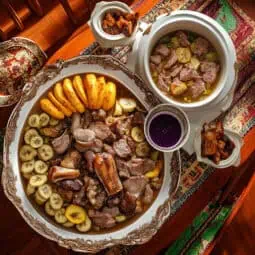
Filipino-Spanish Cocido
Equipment
- Large stock pot (kaldero) For slow-cooking the meat and making the broth
- Wide Pan (kawali) For browning meats and sautéing ingredients
- Slotted Spoon (sandok) For removing scum from the broth
- Sharp knife (kutsilyo) For cutting meats and vegetables
- Cutting board (Sangkalan) For preparation
- Serving platter (bandehado) For presenting the meats and vegetables
- Soup Tureen For serving the broth
- Tongs For handling meats while browning
- Fine-mesh strainer For straining the broth
Ingredients
For the Main Dish
- 1 pound bone-in beef shank buto-buto
- ½ whole chicken manok, cut into serving parts
- 5 ounces chorizo de bilbao
- 4 ounces ham slices hamon
- 3 saba bananas saging na saba, peeled and halved
- 15 ounces garbanzo beans garbanzos, drained
- 1 head cabbage repolyo, quartered
- 8 pieces green beans sitaw, stemmed
- 1 bunch pechay ends trimmed and leaves separated
- 1 large onion sibuyas, peeled and quartered
- 3 cloves garlic bawang, peeled
- 1 teaspoon peppercorns paminta
- 8 cups water tubig
- 2 teaspoons salt asin
- 3 tablespoons canola oil mantika
For the Berenjana Sauce (Eggplant Relish)
- 3 eggplants talong
- 3 cloves garlic bawang, peeled and minced
- 2 tablespoons vinegar suka
- 1 tablespoon oil mantika
- Salt to taste asin
Instructions
- Start by heating one tablespoon of oil in a large pot over medium heat. Sear the beef shanks on both sides until they develop a nice brown color, about 3-4 minutes per side. Remove the beef and set aside.
- Pour the water into the same pot and bring it to a boil. Return the beef shanks to the pot and skim off any gray foam that rises to the surface. Once the broth looks clear, add the quartered onions, whole garlic cloves, peppercorns, and salt. Lower the heat to a gentle simmer, cover the pot, and let it cook for about 1½ to 2 hours, or until the beef is fork-tender.
- While the beef is cooking, prepare your berenjana sauce. Place the whole eggplants directly over an open flame on your stove, turning occasionally until the skin is completely charred. Run them under cold water and peel off the blackened skin. Mash the soft eggplant flesh in a bowl, then mix in the minced garlic, vinegar, oil, and salt to taste. Set this sauce aside.
- In a separate wide pan, heat another tablespoon of oil. Add the saba bananas and cook until they're lightly golden brown on all sides. Remove them and set aside. In the same pan, cook the chorizo de bilbao for 1-2 minutes until it releases its red oil. Remove and set aside. Add the chicken pieces to the pan and cook until they're lightly browned on all sides.
- Once the beef is tender, add the browned chicken, ham slices, and chorizo to the pot. Cook for about 15-20 minutes until the chicken is fully cooked through. Add the garbanzo beans and browned saba bananas, letting them cook for 3-5 minutes to heat through.
- Next, add the green beans and cabbage quarters to the pot. Cook until they're tender but still have a slight crunch. Finally, add the pechay leaves and cook for just one more minute. Taste the broth and add more salt if needed.
- To serve your cocido the traditional way, first ladle the hot, clear broth into bowls as your first course. Then arrange all the vegetables and garbanzo beans on a large platter for your second course. Finally, present all the meats on another platter for the third course. Serve everything with steaming white rice and the berenjena sauce on the side.
- Your cocido is best enjoyed fresh, but if you have leftovers, store everything together in the broth to keep the meat and vegetables from drying out. It will keep well in the refrigerator for up to three days.
Tips from Lola's Kitchen
- Choose beef shanks with plenty of connective tissue for a richer broth
- Don't skip the browning steps - this develops deeper flavors
- Keep the broth at a gentle simmer, not a rolling boil
- Add salt gradually throughout cooking to build flavors
- Choose firm, yellow-green saba bananas for best results
- Let meat rest for 5-10 minutes before serving for juicier results
Nutrition
The Story Behind Filipino-Spanish Cocido
Walk into any Filipino household during a special Sunday lunch or holiday celebration, and you might be lucky enough to find a steaming pot of cocido on the stove. This beloved Filipino stew, also known as pochero in some regions, tells a fascinating story of cultural fusion that spans centuries of Spanish colonial influence in Philippine cuisine.
Originally from Madrid, Spain, where it's known as Cocido Madrileño, this hearty dish made its way to Philippine shores during the 333 years of Spanish colonial rule. Like many Filipino-Spanish dishes, cocido underwent a delicious transformation as local cooks adapted it to include ingredients native to the Philippines, such as the distinctly Filipino saba bananas and pechay leaves.
What makes Filipino cocido truly special is how it embraces both its Spanish roots and Filipino innovations. While the Spanish version traditionally uses morcilla (blood sausage) and various cuts of pork, the Filipino adaptation commonly features a mix of beef shanks, chicken, ham, and chorizo de bilbao. This combination of meats, slow-cooked until tender, creates a rich, flavorful broth that's distinctly Filipino-Spanish in character.
Perhaps the most interesting aspect of cocido is its traditional three-course serving style. Unlike typical Filipino soups like sinigang or nilaga where everything is served in one bowl, cocido is presented in stages. First comes the aromatic broth, clear and rich from hours of slow cooking. Next, diners enjoy the tender vegetables and garbanzo beans. Finally, the feast culminates with the star of the show - the perfectly cooked meats.
The dish's versatility has helped it maintain its place in Filipino cuisine. Whether it's a holiday gathering, a Sunday family lunch, or a way to transform leftover Christmas ham and roast chicken into something new and exciting, cocido adapts to the occasion. Many Filipino families have their own versions, some adding corn on the cob, others including potatoes or different types of local vegetables.
An essential companion to Filipino cocido is the berenjana sauce, a smoky eggplant relish that adds a delicious depth to each bite. This sauce, made from charred eggplants, garlic, and vinegar, is another testament to how Filipino cooks have made this Spanish dish their own, incorporating local preparation methods and taste preferences.
Today, cocido remains a testament to the Philippines' rich culinary heritage, where Spanish traditions meet Filipino creativity. It's more than just a stew - it's a celebration of family, tradition, and the beautiful blending of cultures that makes Filipino cuisine so special. Whether you call it cocido or pochero, this dish continues to bring families together around the table, just as it has for generations.
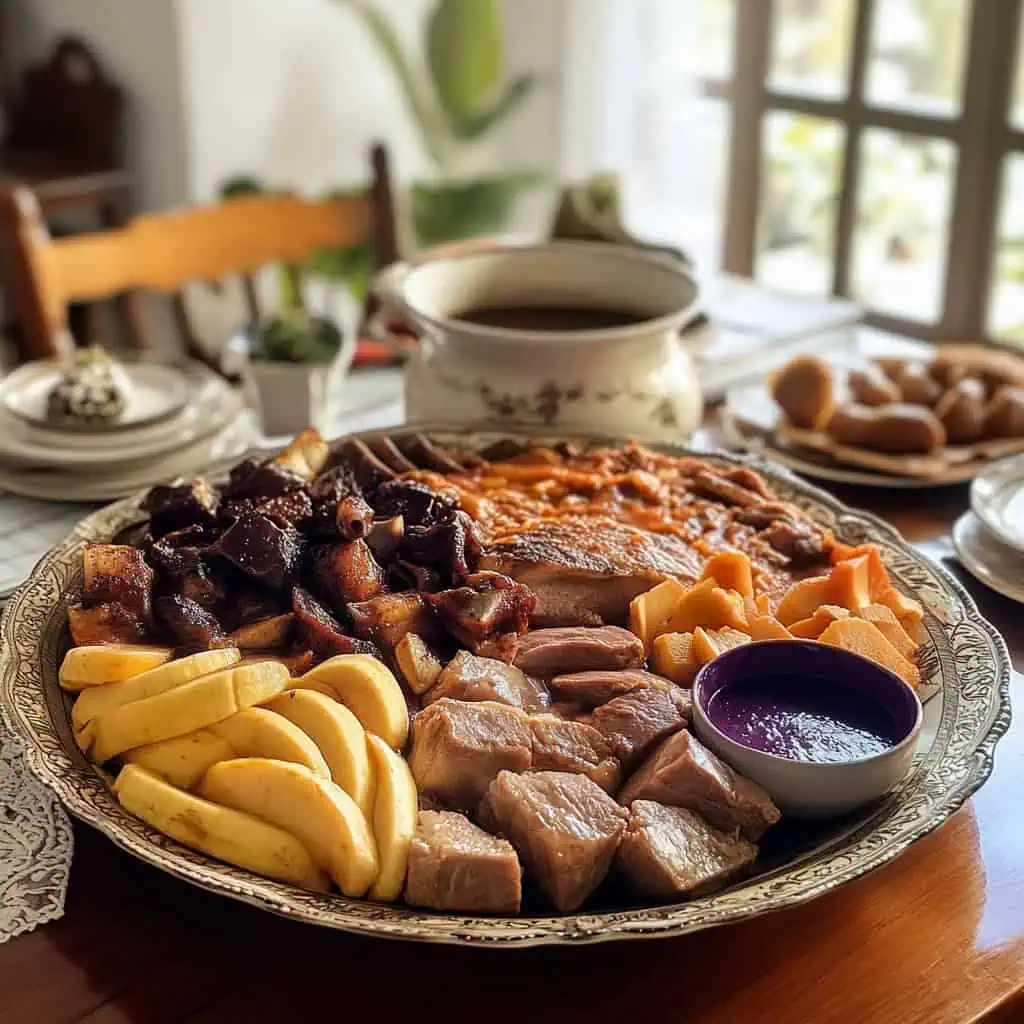









Comments
No Comments